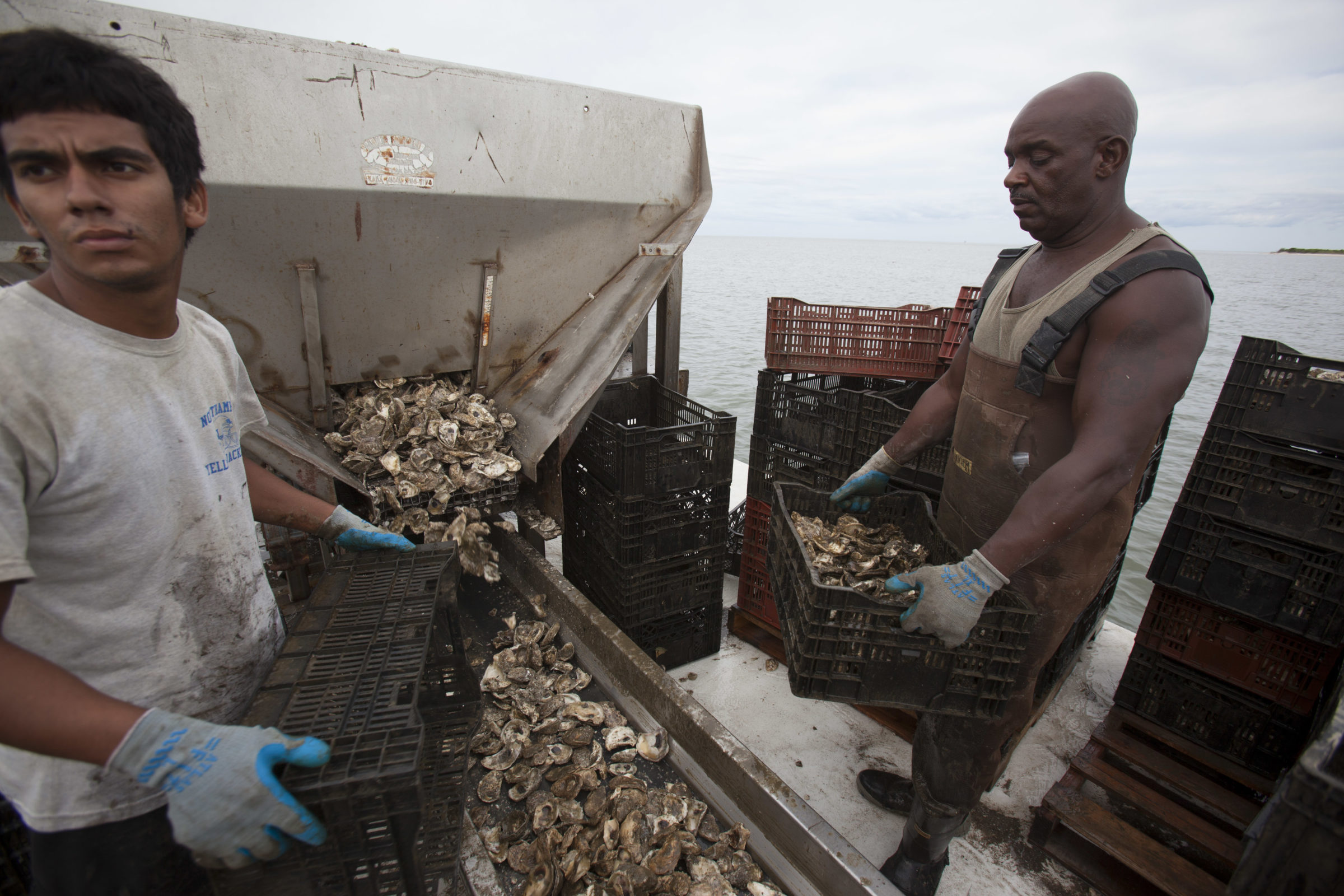Who is Working the Chesapeake Bay Today?
Published by Ocean Conservancy
Black labor has been essential to the Chesapeake Bay region, particularly during the oyster industry boom in the mid-1800s. Traditionally, Black people made up much of the seafood industry labor force in the Chesapeake. So why are there so few Black people working maritime and seafood jobs in the Chesapeake Bay today?
As I demonstrated in the first of this Black History Month blog series, Africans and African Americans helped develop the maritime and seafood industries in the Chesapeake Bay. Still today, Black people are continuing this legacy of working the Bay, including Captain Tyrone Meredith of Kent Island, a fifth-generation waterman who started helping out on his father’s boat when he was six years old. Another person sustaining his family legacy of work in oysters is Gardner Douglas, a military veteran who is now a podcast host and prominent oyster shucker on the Eastern Shore. However, Meredith and Douglas are no longer all that typical, because the number of Black people working the Bay has significantly decreased since the late 1900s. In an interview Meredith did with the Chesapeake Bay Program, he discussed the decline that he’s witnessed in Black watermen and Black people working in shucking houses in Kent Island. According to Meredith, “In 1970, around 100 Black watermen could be found on Kent Island alone. Now you have a handful, maybe about 12 actually left.”
Black men weren’t the only contributors to the success of the seafood industry in the Chesapeake, but unfortunately, it has been challenging to find information dedicated to Black women’s participation in the seafood and maritime industries in the Bay. I came across the story of one modern Black waterwoman—Vera Meredith, who captains a 65foot fishing boat named Island Queen II. However, the history of Black women working on the water remains unclear. Black women did make up the majority of the labor force for seafood processing jobs, particularly oyster shucking and crab picking, in the Chesapeake region. Now, however, it is rare to find African American women working seafood processing jobs in the Chesapeake region.


This decrease in African Americans working maritime and seafood jobs in the Bay can be explained by decreases in catch due to marine habitat changes and overharvesting, as well as increased access to education and stable jobs in urban areas, leading Black people to migrate inland to live and work in urban areas. Changes in state regulations have also affected who is able to work the water. Such regulations include licensing requirements, gear restrictions and area or seasonal closures that have pushed out low-income families that used to work in the seafood industry in the mid-Atlantic. In some places, these new state regulations came at the same time immigrants were entering the seafood industry.
So, who is working the Bay’s waterways today? In the Bay’s seafood processing industry, the majority of the workers are now foreign workers, mostly from Mexico. It has become more and more challenging to find reliable workers for seafood processing jobs (such as crab or oyster processing) because the work is hard, tedious, repetitive and seasonal. Temporary foreign workers are able to work these jobs through H-2B visas, which are available to nonagricultural employers who need to fill seasonal jobs where there are not enough domestic workers to fill those positions. Since the 1980s, for example, the blue crab processing labor force in Maryland, Virginia and North Carolina has shifted from mostly African American women to predominantly Mexican women with H-2B visas.
This demographic shift in labor has posed challenges for the industry, especially in a political climate that is so polarized over the issue of immigration. The seafood processing industry is now dependent on foreign labor, so the industry is threatened when stringent caps are put on H-2B visas, which are now awarded based on lottery rather than a first-come, first-served basis. These changes in the visa program pose a problem for business owners and workers alike. For some small business owners, not receiving enough worker visas is devastating as it could put them out of business. H-2B visa workers come to the United States to work in order to support their families, and when they don’t receive the visas, their livelihoods and the livelihoods of their families are affected. Some workers have consistently come to the United States to work under the visa program, like Olivia Rubio, who has been coming from Mexico to work on Hoopers Island, Maryland for 15 years. Still, the seafood industry’s reliance on foreign workers generates much controversy, particularly related to how this program affects American wages and jobs, the poor working conditions and very low wages for H-2B visa workers in these positions and the exploitation of undocumented workers.
The story of demographic shift in labor force in the Chesapeake Bay shows how ecological, political and policy changes can affect a water body, as well as how a water body can shape culture and economic opportunity. A different population of people of color is now upholding the seafood industry in the Chesapeake Bay and shaping the region. In addition to the shifting fortunes of the Chesapeake’s iconic oysters and crabs, the story of the Bay is one of colonization and slavery, freedom and opportunity, citizenship and migration, transformation and continuity. Still, the history of Black people and presence of Black coastal communities in the Chesapeake remains vibrant, featuring voices like Gardner Douglas: an oyster icon who bridges generations of Black people working in oysters on the Chesapeake.
Sign up for our emails!
The post Who is Working the Chesapeake Bay Today? appeared first on Ocean Conservancy.
Read the full article at: https://oceanconservancy.org/blog/2019/02/28/working-chesapeake-bay-today/


